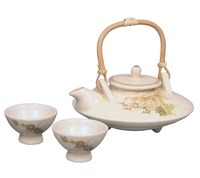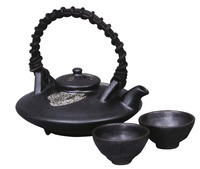

Total:131items
- Pottery & Porcelain (18)
- Koshu Kimen Gawara: Koshu Tile with a Devil’s Face
- Hasami Yaki: Hasami Porcelain
- Kiyomizu Yaki: Kyo style ceramics, Kiyomizu ware
- Otani Yaki: Otani Pottery
- Izushi Yaki: Izushi Porcelain
- Onta-yaki: Onta Pottery
- Takahama Yaki: Takahama Porcelain
- Mushiake- Yaki: Mushiake ware
- Kikuma-Gawara: Kikuma Roof-Tile
- Zeze-Yaki: Zeze ware
- TsutsumiYaki: Tsutsumi Pottery
- Hira Shimizu Yaki: Hira Shimizu Ware
- Tajima Banko Yaki: Tajima Banko Pottery
- Shidoro-Yaki: Shidoro Ware
- Amakusa Tojiki: Amakusa ware
- Shibukusa-yaki: Shibukusa ware
- Karatsu Yaki : Karatsu Ware
- Satsuma-yaki : Satsuma Ware
- Lacquerware (4)
- Glasswork (2)
- Wood & Bamboo Work (19)
- Leather Work (1)
- Papermaking (13)
- Textile (20)
- Dyeing products (5)
- Masonry (1)
- Metal Work (11)
- Stationery (4)
- Livingware (3)
- Accessory (4)
- Toys & Entertainment (14)
- Interior (2)
- Other crafts (10)

 |
Main Production Site:Kagoshima |
 《Characteristics》
《Characteristics》Satsuma-yaki (Satsuma ware) is generally divided into two types: Shiro (white) Satsuma and Kuro (black) Satsuma. They are also called Shiro-mon and Kuro-mon respectively. The word ‘mon’ is Kagoshima (southern Kyūsyū) dialect, the shortened form of ‘mono’ meaning ‘thing’.
Shiro Satsuma, exquisite white ware, possesses both delicacy and elegance. It has a warm, ivory-toned body, which is covered with Kan’nyu--finely crackled transparent glaze--and decorated with motifs such as animals or plants in red, blue, green, and gold (gilt). In the past, because of its rich and gorgeous beauty, Shiro Satsuma was highly prized among the upper classes as their own possession or as gifts. Exceptionally superior ones were exclusively owned by the lord of Satsuma Domain.
In 1867, Satsuma Domain, ruled by the Shimazu clan, exhibited Shiro Satsuma at the Paris International Exposition. Shiro Satsuma was greatly admired for its high aesthetic quality and, as a result, a number of Shiro Satsuma pieces began to be exported and became widely known in Europe as “SATSUMA”.
On the other hand, Kuro Satsuma features a simple, strong appearance and a jet-black luster, which is derived from volcanic ash soils abundant in iron.
In contrast to Shiro Satsuma, which was highly patronized by the lords, Kuro Satsuma was produced for ordinary people and commonly used in daily life. One example is Kuro-joka, a unique sake pot--the word ‘joka’ is Kagoshima dialect, and its plain form is ‘choka’ meaning ‘earthenware teapot’. Kuro-joka are often used to warm shochu, a type of Japanese distilled liquor, and are still favored by people today.
[Traditional Craft designated by Ministry of Economy, Trade and Industry]
-Courtesy of Kagoshima Satsuma Yaki Cooperative Association
Translation by Tae Yamaguchi

| Materials | Clay and glaze, both derived from volcanic ash soils. |
|---|---|
| Crafting Processes | [1] Shaping
There are several techniques for shaping: ・“hand-forming”-- shape the clay entirely by hand ・“wheel-throwing”-- use a potter’s wheel to shape clay ・“molding”-- use a plaster or a bisque mold for shaping [2] Decoration and Drying After shaping, “faceting” and “decoration” are added to the clay; the surface of the clay is cut with a plane, and then decorated with a pallet. [3] Bisque Firing and Glazing The first firing (bisque firing) is done to the decorated greenware at a temperature of 750 to 850°C (1380 to 1560°F), so that it becomes hard and durable. [4] Glaze Firing Load the bisqueware into a kiln for the second firing (glaze firing) which lasts over 12 hours, at approximately 1250°C (2280°F). There are two types of firing: “oxidation firing” and “reduction firing”. In oxidation firing, the atmosphere in the kiln is rich in oxygen; in reduction firing, the oxygen supply is reduced. [5] Overglaze Painting After the glaze firing, decorative painting is applied over the transparent glaze covering the surface of the piece, then the piece is fired again at 750 to 850°C (1380 to 1560°F). [6] Unloading and Finishing The piece is pre-treated with alumina before loading; therefore, once the bottom is finished and the paint chips caused by glaze shivering are removed, the process is complete. |
| History | In 1592 (the first year of Bunroku), TOYOTOMI Hideyoshi, who had already unified Japan, sent 150,000 soldiers to Korea. In those days, Japan was in the full maturity of Momoyama culture--the tea ceremony greatly flourished, and people including feudal lords had a keen interest in tea utensils. Meanwhile, Korea was in remarkable cultural growth of the Joseon Dynasty and especially excelled in ceramics.
The War of Bunroku-Keicho, which had lasted for a long period, finally ended after Hideyoshi’s death. The feudal lords (Daimyo) who had served in the war returned to Japan with Korean cultural products. In particular, the feudal lords of Kyūsyū and Chōsyū (present-day Yamaguchi Prefecture, western Japan) competed to bring Korean potters to their own domain, where they had the potters build kilns. As a result, Satsuma, Arita, Agano, Takatori, and Hagi kilns were established in Kyūsyū region and Yamaguchi Prefecture. This series of events relating to pottery is the reason why the War of Bunroku-Keicho is called the “Pottery Wars”. The feudal lords had their eye on excellent Korean pottery. Each of them made Korean potters produce pottery reflecting his own taste, aiming at industrial development in his own domain. There are two theories on when the Korean potters arrived in Japan; in 1595 or 1598. There are also theories as to where the potters landed, how many potters arrived, and their names. It is believed that Kushikino-shimabira, Higashiichiki-kaminokawa, and Maenohama of Kagoshima Prefecture were the points of entry. The main kilns for Satsuma ware have their roots in these places, and they are broadly categorized into three groups: Tateno, Ryūmonji, and Naeshirogawa kilns. Through both the rich natural resources of Kagoshima and the potter’s ceaseless diligence, Satsuma ware has developed its own style over the long history. Today, a number of kilns exist in Kagoshima, producing pieces using a variety of techniques. |
| Related URL | https://satsumayaki-coop.com/ |
◆Exhibition / Showcase
For more Information:
Kagoshima Satsuma Yaki Cooperative Association
Address:5679, Hiyoshi-cho Hioki, Hioki-shi, Kagoshima, 899-3101 JAPAN
Tel : +81-99-292-5156 Fax: +81-99-292-5191 (Japanese Only)
◆Event Information
Kagoshima Satsuma Yaki Cooperative Association
- The website provides information about events and exhibitions.
For more details:
Assistance needed? For inquiries in English:
JTCO Contact Form
Your inquiries will be forwarded by JTCO in Japanese to the organization you wish to contact.
*Please write the name of craft you wish to ask about.



